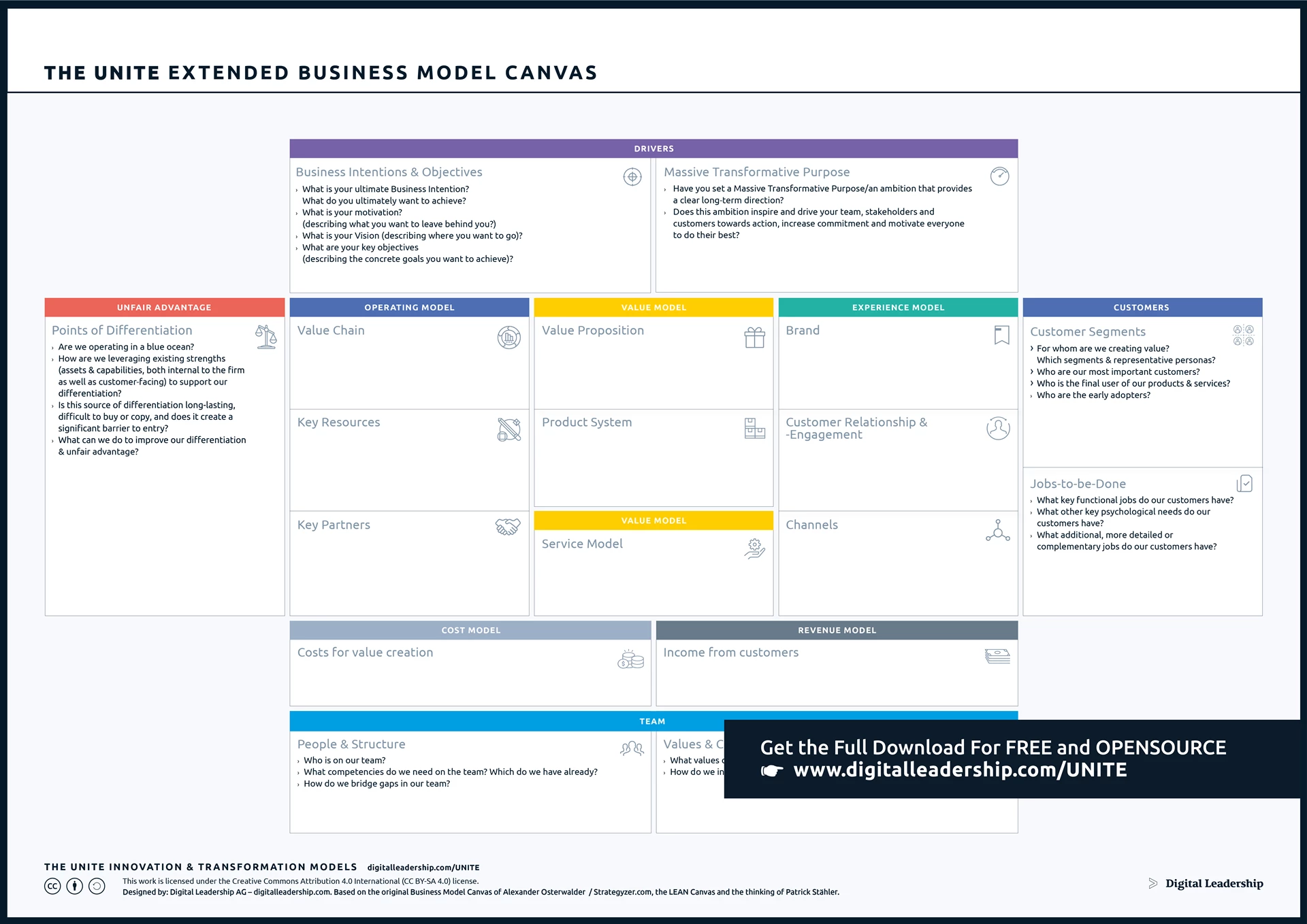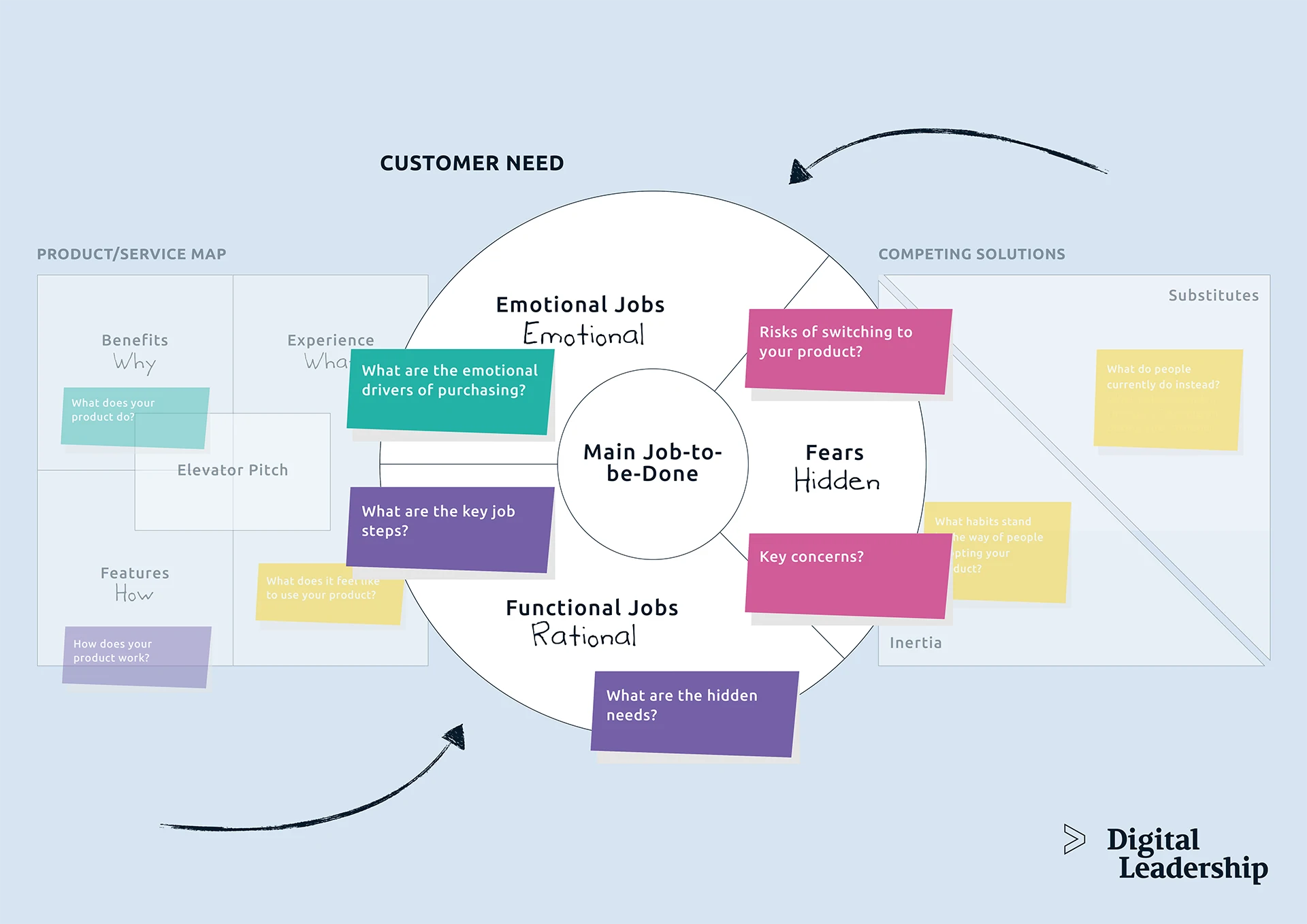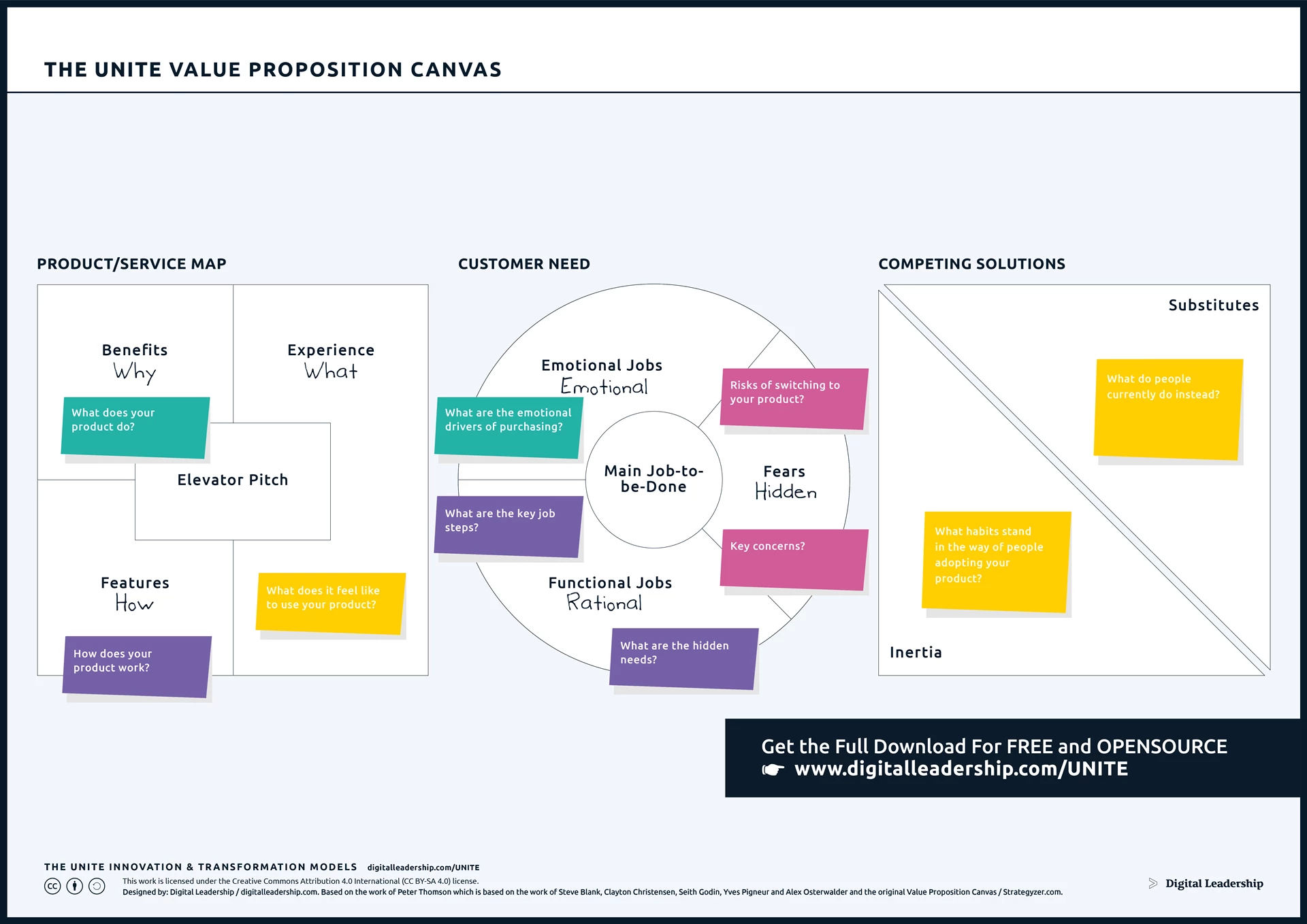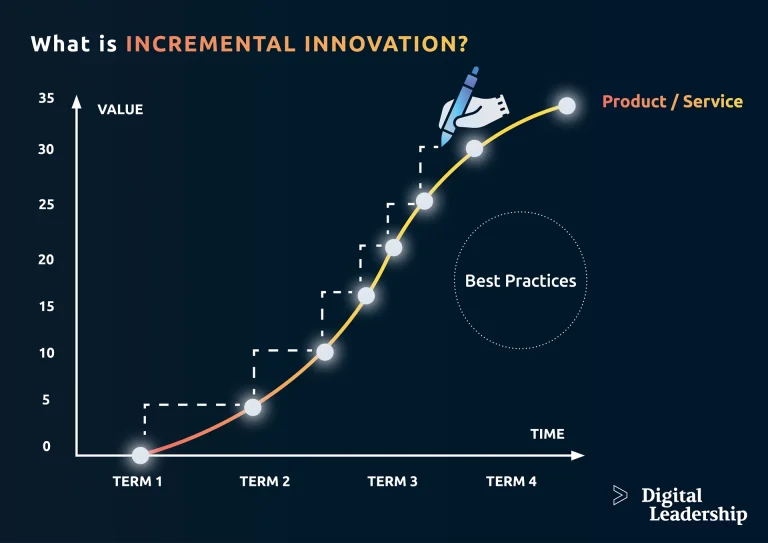Key Partners Building Block of the Business Model Canvas
Published: 19 July, 2023
Business Models

Table of Contents
Introduction to Key Partners Building Block in BMC
In an interconnected world, leveraging relationships with ecosystem partners has become increasingly important because it allows you to focus on your relative strengths. Think about the four different types of partnerships, including strategic alliances between non-competitors, coopetition (strategic partnerships between competitors), joint ventures to develop new businesses, and buyer-supplier relationships to assure reliable supplies.
Key Partners are essential relationships that a company has with other entities, like suppliers, manufacturers, or advisors. These partnerships provide vital support, helping the business model to function effectively in areas where it would be inefficient to handle everything on its own. Introducing our Extended Business Model Canvas – a powerful tool that takes your business planning to the next level. This innovative framework goes beyond the traditional canvas by incorporating crucial elements such as Key Partners, Business Drivers, customers, the team, and the Unfair Advantage. Unlock the full potential of your business and download the model now to take the first step towards achieving your goals and thriving in today’s dynamic market landscape.

Designed by: Digital Leadership AG – Building on the work of Alexander Osterwalder, the Lean Canvas and the thinking of Patrick Stahler
Key Partners in Business Model Canvas
Key Partners is one of the building blocks of the Business Model Canvas and plays a crucial role in the success of a business. At Digital Leadership, we provide Business Model Strategy and Marketing Strategy Consulting services to serve as a blueprint that outlines how the business operates, generates revenue, and creates value for its customers. A well-developed Business Model Strategy helps in identifying the target market, understanding customer needs, and designing products or services that meet those needs effectively. While Marketing Strategy Consulting service plays a pivotal role in helping businesses navigate the complex and ever-changing landscape of marketing.

Once you understand your Value Chains, Key Resources, and Key Partners, it should be relatively easy to identify the key cost drivers and potential Opportunity Spaces for innovation. For any Business Model, managing costs is critical, but some Business Models are designed entirely around low-cost structures, such as “no-frills” airlines. What role do costs play in your Business Model? Are you seeking to simply optimize them, or could they play a more differentiating role?
You can find comprehensive information about all the Building Blocks in the Business Model Canvas, just like always. About all Building Blocks in Business Model Canvas available on the Digital Leadership website and in our book, How to Create Innovation This comprehensive resource delves into Jobs to be done, organizational structures, and strategies that empower you to innovate efficiently, achieving maximum success by optimizing resource utilization.
Key Partners Examples
Apple Company:
- Key Partners: Original Equipment Manufacturers (OEMs)
- Type of Partnership: Buyer-Supplier Relationship
- Description: Apple relies on OEMs like Foxconn, which employs over 200,000 workers in Shenzen, China, to manufacture its products.
- Key Partners: App Developers and Record Companies
- Type of Partnership: Strategic Alliances
- Description: When Apple opened the iTunes Store, it formed strategic alliances with app developers and record companies to offer a wide range of apps and music to its customers.
Airbnb Company:
- Key Partners: Insurances, Investors, and Payment Processors
- Type of Partnership: Buyer-Supplier Relationship
- Description: Airbnb collaborates with insurance providers, investors, and payment processors to ensure smooth transactions and provide insurance coverage for hosts and guests.
- Key Partners: Tesla Motors
- Type of Partnership: Joint Ventures
- Description: Airbnb engaged in a joint venture with Tesla Motors to install charging stations at select hosts’ homes along the West Coast, promoting eco-friendly travel options for guests.
- Key Partners: Companies for Sponsored Events
- Type of Partnership: Strategic Alliances
- Description: Airbnb forms strategic alliances with companies to sponsor events, expanding its brand visibility and attracting more potential hosts and guests.
- Key Partners: Freelance Photographers
- Type of Partnership: Not specified
- Description: Airbnb involved freelance photographers to improve the quality of property listings and increase hosts’ retention.
E-commerce Platform:
- Key Partners: Logistics Companies, Social Media Platforms, Payment Gateways
- Type of Partnership: Buyer-Supplier Relationship (with logistics and payment partners) and Strategic Alliances (with social media platforms)
- Description: An e-commerce platform collaborates with logistics companies and payment gateways to handle product delivery and transactions efficiently. Additionally, it forms strategic alliances with social media platforms to boost brand exposure and attract customers through advertising and promotions.
Ride-Sharing Service:
- Key Partners: Car Manufacturers for Fleet Partnerships, Mobile App Development Companies, Insurance Providers
- Type of Partnership: Buyer-Supplier Relationship (with car manufacturers and insurance providers) and Strategic Alliances (with app development companies)
- Description: A ride-sharing service forms fleet partnerships with car manufacturers to expand its vehicle fleet. It collaborates with mobile app development companies to enhance its app’s features and user experience. Additionally, it collaborates with insurance providers to offer insurance coverage for drivers and passengers.
Health-Tech Startup:
- Key Partners: Medical Equipment Suppliers, Healthcare Institutions for Research Collaborations, Mobile Health App Developers
- Type of Partnership: Buyer-Supplier Relationship (with medical equipment suppliers) and Strategic Alliances (with healthcare institutions and app developers)
- Description: A health-tech startup collaborates with medical equipment suppliers to source necessary devices for its healthcare solutions. It forms strategic alliances with healthcare institutions to conduct research and trials. Additionally, it partners with mobile health app developers to integrate health tracking features into its platform.
Key Partners’ main types
Key partnerships can be classified in four ways, with each arrangement having its own advantages and disadvantages.
Importantly, no matter the flavor of partnership, these agreements result in the creation of key partners for both business entities and therefore must be managed, cultivated, and regularly reviewed for their place in each company’s business model.
1. Strategic Alliances Partnerships:
- In strategic alliances, both companies agree to undertake a project that is mutually beneficial while remaining independent. This type of partnership is helpful in a competitive environment, as both companies share liability exposure. Examples include franchising, licensing, and affiliate marketing.
2. Coopetition Partnerships:
- Description: Coopetition partnerships involve rival companies forming a strategic partnership to achieve mutual benefits. This collaboration can lead to positive outcomes for both entities. An example is the cooperation between Pfizer and BioNTech to develop and distribute a COVID-19 vaccine.
3. Joint-Ventures Relationships:
- In joint ventures, two independent companies agree to work together on a specific project and share particular resources. This type of partnership is focused on a single joint project, distinguishing it from other partnerships. Joint ventures may cause conflicts between entities, and some experts advise caution with this type of key partnership.
4. Buyer-Supplier Relationships:
- Description: Buyer-supplier relationships involve commercial agreements for the purchase and supply of goods or services. These relationships are essential for businesses to deliver on their value proposition effectively. Buyers and suppliers are among the most critical key partners for a business. Maintaining productive buyer-supplier relationships is crucial for a company’s success, no matter which end of your company works is one of a business’s most important key activities.
Why do we Need Strategic Partnerships?
In a competitive environment characterized by the need for the reduction of risk and uncertainty, strategic partnerships offer the opportunity to build relationships and reduce costs. They reduce risk by diffusing exposure to changing business environments across the two companies.
Many times, strategic partnerships form a powerful building block of a business model by making key resources available at a manageable cost. Partners perform valuable services that would otherwise distract from our main value propositions.
The right partners perform important functions and help us complete our key activities and our customers’ Jobs to Be Done.

How do you Choose Your Key Partners?
Key partners are an important section of the business model canvas and business models as a whole. You should consider cultivating your key partnerships as one of your business’s key activities, which we’ve discussed elsewhere on the Digital Leadership website.
There can be no set rules for choosing your key partners. So much will depend on the specifics of your value proposition, their value proposition, and the overall business model of both companies. We thought about the factors behind successful key partnerships, however, and we think we’ve identified some common characteristics to keep in mind when choosing a key partner. Unlock the full potential of your business partnerships with The Unite Value Proposition Canvas Model, a comprehensive framework designed to help you identify and leverage successful key partnerships. By aligning your value proposition with that of your potential partners and understanding the overall business models of both companies, you can make informed decisions to create mutually beneficial relationships. You can download it now.

Designed by: Digital Leadership AG – Based on the work of Peter Thomson which is based on the work of Steve Blank, Clayton Christensen, Seith Godin, Yves Pigneur, and Alex Osterwalder and the original Value Proposition Canvas
Factors to Keep in Mind When Choosing Your Partnerships
1- Mission-critical
Only create the key partnerships that your value proposition requires. Forming partnerships should be of necessity.
2- Geography
Is the potential partnership geographically sensible? Your supply chain may have requirements mandated by other key suppliers and partnerships.
A car manufacturer needs particular resources at a certain time. If the supply chain is stretched too far, the company won’t be able to meet its production obligations.
3- Complementary needs
The arrangement must make sense for both companies beyond just the reduction of risk. Are you both stronger against competitors as a result of the partnership?
4- Business model appropriate
Finally, is this potential new partner appropriate for your overall business model? Do they fit in your business model canvas in a way that makes sense?
New key partners shouldn’t just barely make it into your circle. They should be added because they make your business model work and your business requires them to be successful.
The UNITE Business Model Framework
The UNITE Business Model Framework plays a pivotal role in the importance of key partners in business partnerships. This framework provides a structured and strategic approach to identifying, evaluating, and fostering successful key partnerships.
Here is a summary of the key ingredients of the framework:

Designed By: Digital Leadership AG
Business Models
The centerpiece is the Business Model Canvas, which covers the six main areas of a Business Model (the Operating, Value, Service, Experience, Cost, and Revenue Streams “Model”).
The eXtended Business Model Canvas adds the immediate business context, including Business Drivers, customers, and the team, as well as the Unfair Advantage.
Detailed Models
A Business Model can be broken out into numerous aspects. Depending on what challenges you face, you can zoom in on your area of interest using an appropriate tool or canvas:
- Your Business Intention and objectives as well as your Massive Transformative Purpose summarize your drivers and give direction to what you do.
- The Value Proposition Canvas details the central components of your offering (the product or service).
- To dig into your Customer Segments, work with data-driven Personas.
- The JTBD Customer Job Statement and Job Map frame the JTBD of your customers.
- The Business Model Environment puts your Business Model in a market context composed of emerging trends and disruptive forces.
- The Innovation Culture Canvas helps you understand and consciously shape a culture that supports innovation.
- The Innovation team structure enables you to draft a team structure for your innovation initiative.
- Using learning and growth metrics, you can measure progress at the initial stages of development. These metrics help you focus on what really matters instead of creating a detailed business plan that will not really help you. Later on, you can expand the financial aspect of the Revenue and Cost Models with a full business case.
- The Operating Model Canvas helps you think through the Operating Model.
Conclusion
The Key Partners building block in the Business Model Canvas outlines crucial partnerships that enhance a business’s operations and success. These partnerships can be strategic alliances, coopetition, joint ventures, or buyer-supplier relationships. By choosing partners wisely and managing them effectively, businesses can reduce risk, access key resources, and deliver value to customers. Emphasizing key partnerships is essential in today’s interconnected world, driving innovation and competitiveness.
Frequently Asked Questions
1. What are key partners in sales?
Key partners in sales are individuals, companies, or organizations that collaborate with a business to enhance its sales activities. These partners can be suppliers, distributors, resellers, or other entities that contribute to the sales process by providing access to new markets, customer segments, or distribution channels. Establishing strong partnerships can help a company reach a wider audience and increase sales opportunities.
2. What is the difference between key partners and stakeholders?
Key partners are specific entities or organizations that collaborate directly with a business to achieve common goals or objectives, while stakeholders encompass a broader group of individuals or entities with an interest in the business’s activities, success, or outcomes. Stakeholders can include employees, customers, investors, suppliers, regulators, and more, whereas key partners are those crucial collaborators directly involved in a business’s operations or strategic initiatives.
3. Can customers be key partners?
Yes, customers can be key partners in certain business models. In some cases, businesses might adopt a customer-centric approach and involve their customers in product development, co-creation, or feedback processes. Customer feedback and insights can be invaluable in shaping products and services that better meet the needs of the target market.
4. What is a key strategic partner?
A key strategic partner is a significant collaborator critical to the success of a business’s overall strategic objectives. These partners are chosen strategically to leverage their resources, capabilities, or market reach to achieve common goals and gain a competitive advantage.
5. What are key partnerships in a business plan?
In a business plan, key partnerships refer to the strategic collaborations that a company intends to establish with other entities to support its operations and growth. These partnerships can play a crucial role in achieving various aspects of the business’s value proposition, distribution, revenue generation, and market presence. Including key partnerships in a business plan demonstrates a clear understanding of the collaborative opportunities that can enhance the company’s success.

































 Book How to Create Innovation
Book How to Create Innovation